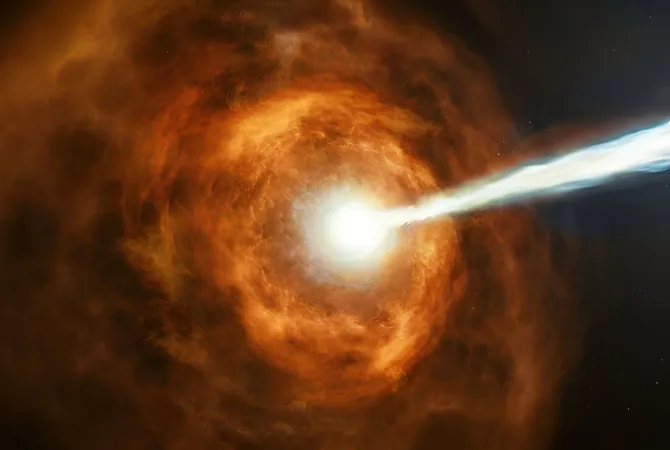
Astronomers Stunned by Unprecedented Gamma-Ray Burst That Defies All Expectations
2025-09-10
Author: Nur
The cosmos has once again delivered a spectacle beyond imagination: a gamma-ray burst (GRB) that has left astronomers in awe. Normally, these extraordinary explosions signal the fiery deaths of massive stars, lasting only a fleetingly short time. However, a recent GRB has shattered all norms.
GRB 250702B: A Cosmic Mystery Unfolds
The newly identified burst, dubbed GRB 250702B, was documented in The Astrophysical Journal Letters. Dr. Antonio Martin-Carrillo and his team utilized the prestigious Very Large Telescope at the European Southern Observatory to delve deep into this enigmatic event.
Dr. Martin-Carrillo emphasized the uniqueness of this observation, stating, "In 50 years of studying gamma-ray bursts, we've never seen anything like this. Typically, GRBs happen just once as they come from sources that don’t survive the catastrophic explosion. But this one showed a remarkable pattern of repeated activity, suggesting some kind of periodic behavior."
What Caused This Unusual Burst?
Astronomers are now pondering the possible origins of this bizarre burst. One theory proposes that it may have resulted from a massive star collapsing, feeding the central engine for an extended period. Another possibility involves a star being ripped apart by a black hole in a tidal disruption event.
Intriguingly, data suggests that a white dwarf might have been engulfed by an elusive intermediate-mass black hole, a phenomenon theorized yet seldom observed.
An Unending Cosmic Show
Unlike typical bursts lasting mere milliseconds to minutes, GRB 250702B persisted for about a day—hundreds of times longer than usual. Professor Andrew Levan from Radboud University noted this remarkable duration, saying it was 100 to 1,000 times longer than most GRBs.
The unusual timing of the bursts, hinting at integer multiples, suggests a kind of cyclical nature never previously documented.
Mapping the Source of the Burst
Initial signals from this event were detected by NASA’s Fermi Gamma-ray Space Telescope and the Chinese Academy of Sciences’ Einstein Probe. However, it was the Very Large Telescope that ultimately pinpointed its location outside our galaxy—changing previous assumptions about its proximity.
"Initially, we believed it might originate from within our galaxy but the VLT provided crucial data that shifted that understanding," explained Professor Levan.
Revealing the Host Galaxy
The HAWK-I camera on the VLT unveiled an extremely reddened infrared counterpart, indicating an obscured source laden with dust. Following imaging with the Hubble Space Telescope confirmed that the host galaxy exhibited a complex and asymmetrical structure, possibly hiding more mysteries within its dust lanes.
Dr. Martin-Carrillo pointed out that the extragalactic nature of this object significantly enhances its power.
The Afterglow: A Clue to Understanding
The afterglow observed in X-ray, infrared, and radio wavelengths aligns with models suggesting a collision of relativistic jets with surrounding materials. However, the data indicated a uniquely narrow jet angle and substantial dust extinction, diverging from what is typically seen.
Potential Explanations Emerge
The researchers proposed four scenarios: a relativistic tidal disruption event possibly involving a white dwarf and an intermediate-mass black hole; a non-standard stellar collapse; echoes from gamma-ray scattering through dense dust; or the burst emerging from a distant source amplified by gravitational lensing.
As captivating as these theories are, the first two currently align most closely with the gathered data.
A New Chapter in Cosmic Exploration
Despite these tantalizing possibilities, the true nature of GRB 250702B remains a puzzle. Dr. Martin-Carrillo stated, "We’re still grappling with the origin of this burst, but this research marks a significant step toward decoding this extraordinary event."
Looking ahead, continued observations—especially with the James Webb Space Telescope—could unravel further mysteries, potentially clarifying whether this burst stems from a dramatic star collapse or something entirely new.
In any case, GRB 250702B has forever altered the landscape of our understanding of cosmic explosions.




 Brasil (PT)
Brasil (PT)
 Canada (EN)
Canada (EN)
 Chile (ES)
Chile (ES)
 Česko (CS)
Česko (CS)
 대한민국 (KO)
대한민국 (KO)
 España (ES)
España (ES)
 France (FR)
France (FR)
 Hong Kong (EN)
Hong Kong (EN)
 Italia (IT)
Italia (IT)
 日本 (JA)
日本 (JA)
 Magyarország (HU)
Magyarország (HU)
 Norge (NO)
Norge (NO)
 Polska (PL)
Polska (PL)
 Schweiz (DE)
Schweiz (DE)
 Singapore (EN)
Singapore (EN)
 Sverige (SV)
Sverige (SV)
 Suomi (FI)
Suomi (FI)
 Türkiye (TR)
Türkiye (TR)
 الإمارات العربية المتحدة (AR)
الإمارات العربية المتحدة (AR)